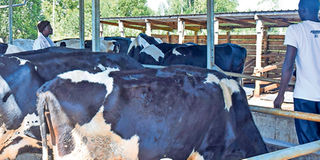Where dairy farmers go for trusted lessons

Workers attend to dairy cattle at the Matungu Smart Farm in Kakamega. On the seven-acre farm, the county keeps 25 dairy cattle. PHOTO | ELIZABETH OJINA | NATION MEDIA GROUP
What you need to know:
- These are the model farms established by the county government in bid to lift up dairy farming in the region, which is picking up after the collapse of the cane sector.
- With the other two other farms, it was set up in 2017 after the county government bought dairy cows from farms in Kiambu and Rift Valley.
- On the seven-acre Matungu farm, the county also keeps 25 animals, with farm manager Paul Shivina noting it was started in 2018.
- Prof Matthew Dida of Maseno University’s Department of Agriculture says before setting up any dairy farm, it is important to know the potential market.
One farm is in Bukura, another in Matungu and the third in Kabras, giving dairy farmers in Kakamega County options when they want practical lessons.
These are the model farms established by the county government in a bid to lift up dairy farming in the region, which is picking up after the collapse of the cane sector.
The county calls them smart farms and at the Bukura facility, Seeds of Gold meets Jane Matangala, the farm manager, and her team of four workers.
The workers are in the process of milking their 13 cows for the second time, a process that lasts an hour-and-a-half.
“We do the first milking at 6am and sell the milk soon after to schools and vendors, who in turn sale the produce in the markets and various centres," says Jane, noting the farm sits on 10 acres.
It hosts 25 cows and 13 are lactating, from which they milk 300 litres daily, with the highest yielder offering 25 litres while lowest 17.
With the other two other farms, it was set up in 2017 after the county government bought dairy cows from farms in Kiambu and Rift Valley.
“We have 23 Friesian cows which we bought at Sh245,500 each and the two Ayrshire cows at Sh135,000 each,” says Jane.
Besides the use of milking machines and keeping of top dairy cows, other things that make farmers troop to the farm for lessons, include a silage pit, where they make the feed from maize plants and molasses, and modern cowshed with various sections that include maternity unit and milking section.
"We make silage using yellow maize grown on the farm. In it we add cotton seed cake and molasses before burying the silage in pits 6 feet deep," she says.
KNOW THE POTENTIAL MARKET
The dairy cows are fed twice a day, in the morning and evening with hay, silage and plenty of water. “We deworm the animals regularly and spray them to control ticks and mites.”
On the seven-acre Matungu farm, the county also keeps 25 animals, with farm manager Paul Shivina noting it was started in 2018.
“We are supplied with hay, concentrates like dairy meal and weaner meal. We buy the hay from Kitale ADC and other concentrates from manufacturers.”

Workers mix silage at the Kakamega County Government farm in Matungu. It is one of the model farms established by the county government in a bid to uplift dairy farming in the region, which is picking up after the collapse of the cane sector. PHOTO | ELIZABETH OJINA | NATION MEDIA GROUP
From the Bukura farm, the county makes milk sales of between Sh45,000 and Sh50,000 weekly while Matungu rakes in from Sh30,000 to Sh40000.
“We sell the milk at Sh40 a litre to schools, retailers and Kakamega Dairy Co-operative,” says Shivina.
George Omusula, the CEO of the farms, says the ultimate goal is for the farms to act as a source of pure breed animals, produce milk for the upcoming milk factory in Malava, transfer knowledge to farmers and also offer market to farmers growing fodder.
“To sustain the 6,000-litre capacity milk factory, the county needs to set up at least 12 such smart farms and work with farmers with similar production units.”
He notes that the farms are complimenting dairy farming in the county. “The demand for milk is high, remember we are setting up a milk processing plant in Malava. Definitely, we will need more milk including from farmers to sustain the plant.”
Prof Matthew Dida of Maseno University’s Department of Agriculture says before setting up any dairy farm, it is important to know the potential market.
“The idea by county government to start model farms is good provided it boosts knowledge for local dairy farmers but it should not compete with them,” he says.




